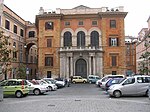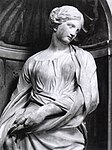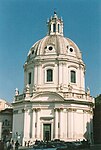The Saint Susanna is a marble sculpture by François Duquesnoy. The work is one of four sculptures of Roman virgin martyrs commissioned by the Bakers' Guild to decorate the church of Santa Maria di Loreto in Rome. It was completed in the course of four years from 1629 to 1633. Giovanni Pietro Bellori, comparing Duquesnoy's achievement with the Saint Susanna to that of Polyclitus with his Doryphoros and its Kanon, commented [Duquesnoy has] left to modern sculptors the example for statues of clothed figures, making him more than the equal of the best ancient sculptor. The statue is considered by modern scholars an exemplification of Duquesnoy's 'Greek ideal,' which included an approach to drapery unpopular at the time, established through the study of antique models selected by Duquesnoy.Duquesnoy's maniera greca would later influence Johann Joachim Winckelmann, and through him the Neoclassicism movement. Jacob Burckhardt regarded the sculpture as "the best statue of the 17th century." With its clinging drapery juxtaposed to her modest gaze and clothing, Duquesnoy's Santa Susanna was considered by contemporaries an "admixture of eroticism and modesty." The figure follows the concept whereby "the drapery should not be so thick as to make it appear like stone, but must be arranged around the body in folds, so that the nude underneath is sometimes discernible but sometimes artfully concealed without any hardness which can obscure the members of the figure." Such approach was at odds with the spectrum of contemporary sculpture, specifically Bernini's expressive use of heavy, billowing drapery. Duquesnoy's St. Susanna doesn't look upwards to heaven, but down at humanity, with her hand pointing down to the altar. This, too, was at odds with Bernini's exuberance and mystification of naturalness and humanity.The Santa Susanna made a powerful impression on contemporary artists and critics, provoking "admiration as well as critical debate over its style and relation to the antique." However, the sculpture did not become widely recognized outside Rome until 18th century. In the early 18th century, Domenico de Rossi's engraving of the statue helped to initially increase its celebrity, which was consolidated internationally when a copy by Coustou was completed and sent to the Paris' academy at the Louvre in 1739.











